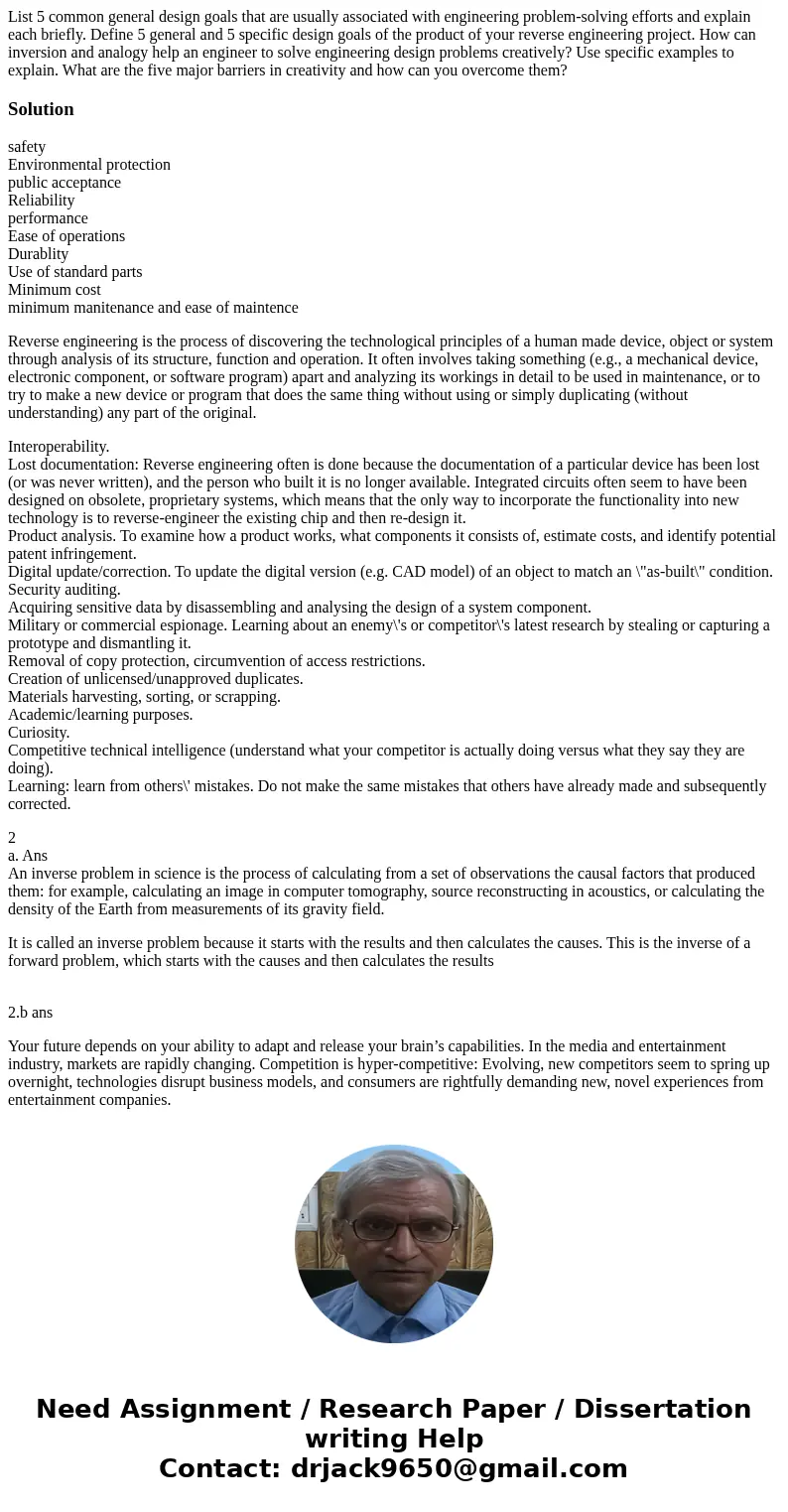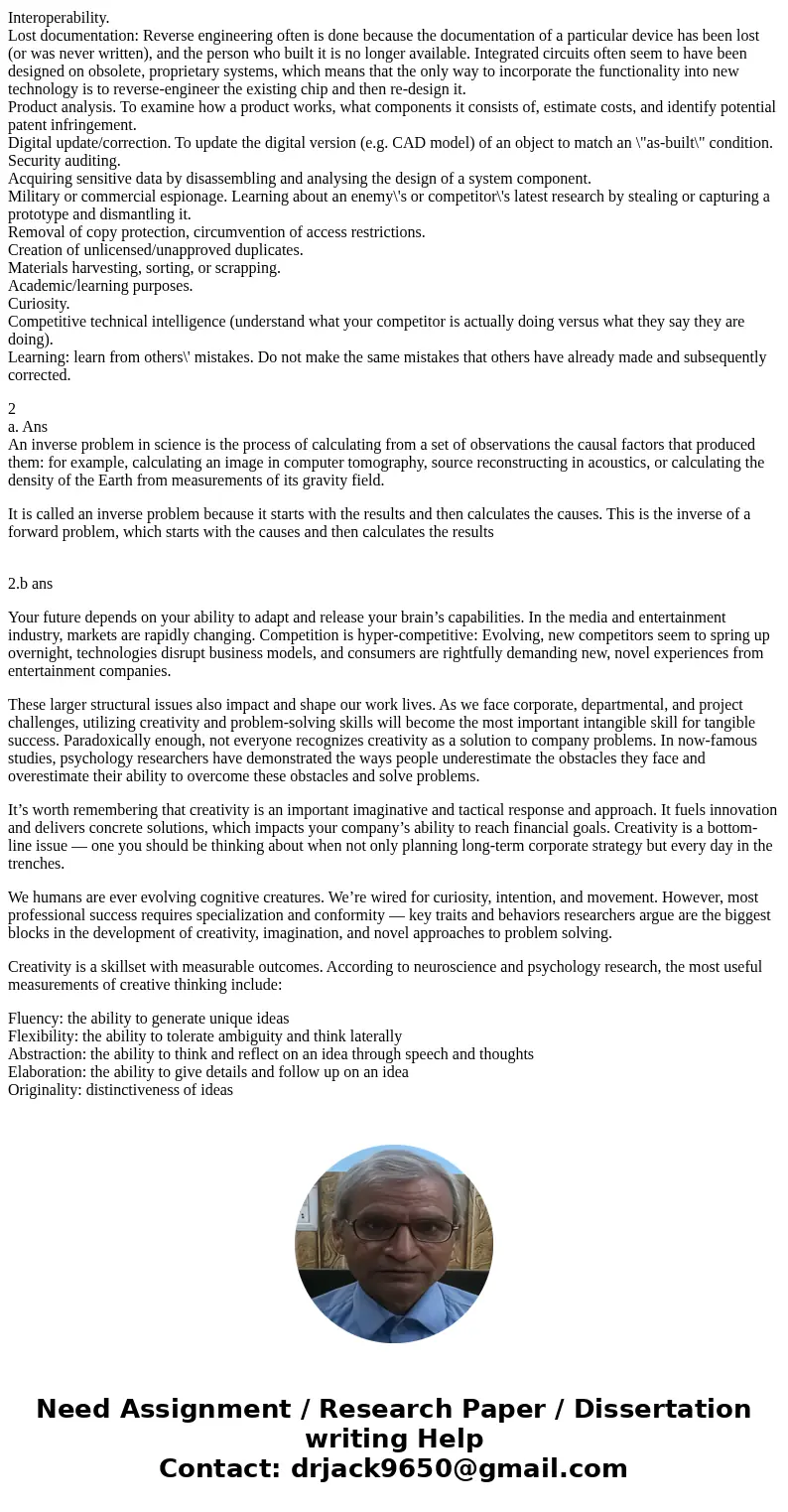List 5 common general design goals that are usually associat
Solution
safety
Environmental protection
public acceptance
Reliability
performance
Ease of operations
Durablity
Use of standard parts
Minimum cost
minimum manitenance and ease of maintence
Reverse engineering is the process of discovering the technological principles of a human made device, object or system through analysis of its structure, function and operation. It often involves taking something (e.g., a mechanical device, electronic component, or software program) apart and analyzing its workings in detail to be used in maintenance, or to try to make a new device or program that does the same thing without using or simply duplicating (without understanding) any part of the original.
Interoperability.
Lost documentation: Reverse engineering often is done because the documentation of a particular device has been lost (or was never written), and the person who built it is no longer available. Integrated circuits often seem to have been designed on obsolete, proprietary systems, which means that the only way to incorporate the functionality into new technology is to reverse-engineer the existing chip and then re-design it.
Product analysis. To examine how a product works, what components it consists of, estimate costs, and identify potential patent infringement.
Digital update/correction. To update the digital version (e.g. CAD model) of an object to match an \"as-built\" condition.
Security auditing.
Acquiring sensitive data by disassembling and analysing the design of a system component.
Military or commercial espionage. Learning about an enemy\'s or competitor\'s latest research by stealing or capturing a prototype and dismantling it.
Removal of copy protection, circumvention of access restrictions.
Creation of unlicensed/unapproved duplicates.
Materials harvesting, sorting, or scrapping.
Academic/learning purposes.
Curiosity.
Competitive technical intelligence (understand what your competitor is actually doing versus what they say they are doing).
Learning: learn from others\' mistakes. Do not make the same mistakes that others have already made and subsequently corrected.
2
a. Ans
An inverse problem in science is the process of calculating from a set of observations the causal factors that produced them: for example, calculating an image in computer tomography, source reconstructing in acoustics, or calculating the density of the Earth from measurements of its gravity field.
It is called an inverse problem because it starts with the results and then calculates the causes. This is the inverse of a forward problem, which starts with the causes and then calculates the results
2.b ans
Your future depends on your ability to adapt and release your brain’s capabilities. In the media and entertainment industry, markets are rapidly changing. Competition is hyper-competitive: Evolving, new competitors seem to spring up overnight, technologies disrupt business models, and consumers are rightfully demanding new, novel experiences from entertainment companies.
These larger structural issues also impact and shape our work lives. As we face corporate, departmental, and project challenges, utilizing creativity and problem-solving skills will become the most important intangible skill for tangible success. Paradoxically enough, not everyone recognizes creativity as a solution to company problems. In now-famous studies, psychology researchers have demonstrated the ways people underestimate the obstacles they face and overestimate their ability to overcome these obstacles and solve problems.
It’s worth remembering that creativity is an important imaginative and tactical response and approach. It fuels innovation and delivers concrete solutions, which impacts your company’s ability to reach financial goals. Creativity is a bottom-line issue — one you should be thinking about when not only planning long-term corporate strategy but every day in the trenches.
We humans are ever evolving cognitive creatures. We’re wired for curiosity, intention, and movement. However, most professional success requires specialization and conformity — key traits and behaviors researchers argue are the biggest blocks in the development of creativity, imagination, and novel approaches to problem solving.
Creativity is a skillset with measurable outcomes. According to neuroscience and psychology research, the most useful measurements of creative thinking include:
Fluency: the ability to generate unique ideas
Flexibility: the ability to tolerate ambiguity and think laterally
Abstraction: the ability to think and reflect on an idea through speech and thoughts
Elaboration: the ability to give details and follow up on an idea
Originality: distinctiveness of ideas


 Homework Sourse
Homework Sourse